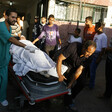The Electronic Intifada 22 January 2009
GAZA CITY, occupied Gaza Strip (IPS) - Eighteen-year-old Mona al-Ashkar says she did not immediately know the first explosion at the United Nations school in Beit Lahiya had blown her left leg off. There was smoke, then chaos, then the pain and disbelief set in once she realized it was gone — completely severed by the weapon that hit her.
Mona is one of the many patients among the 5,500 injured that have international and Palestinian doctors baffled by the type of weaponry used in the Israeli operation. High-profile human rights organizations like Amnesty International are accusing Israel of war crimes.
Mona’s doctors at Gaza City’s al-Shifa hospital found no shrapnel in her leg, and it looked as though it had been “sliced right off with a knife.”
“We are not sure exactly what type of weapon can manage to do that immediately and so cleanly,” said Dr. Sobhi Skaik, consultant surgeon general at al-Shifa hospital. “What is happening is frightening. It’s possible the Israeli army was using Gaza to experiment militarily.”
Both international organizations and human rights groups, including the UN, Human Rights Watch and Amnesty International, have condemned Israel’s use of unconventional weapons in civilian areas of the Gaza Strip.
Amnesty International’s chief researcher for Israel and the Occupied Palestinian Territories, Donatella Rovera, told IPS in Beit Lahiya that Israel’s use of white phosphorus and other “area weapons” on civilian populations amounted to war crimes.
“The kind of weapons used and the manner in which they were used indicates prima facie evidence of war crimes,” she said.
Israel announced Wednesday it would be launching its own probe into reported use of white phosphorus, but has so far refused to comment further.
The International Atomic Energy Agency (IAEA), the UN’s nuclear watchdog, said it would look into a claim made by the ambassadors of a number of Arab nations that Israel used depleted uranium in its recent attacks on Gaza.
Local doctors say a number of both widespread and unusual injuries may indicate that new types of weapons were used on the Gaza population during the war. Health officials are seeing wounds they have never seen before, or at least not on such a massive scale.
“There has been a significant loss of life here in Gaza for reasons that are unexplainable medically,” said Dr. Skaik.
Mona’s injury is characteristic of Dense Inert Metal Explosives (DIME). DIMEs are munitions that, packed with tungsten powder, produce an intense explosion at about the level of the knee, with signs of severe heat at the point of amputation.
“If you ask a patient how it happened, how their leg was removed, they won’t know,” Dr. Skaik said. “They’ll say that a rocket or missile exploded and took only their lower limbs off.”
Once in the body, tungsten is both difficult to detect and extremely carcinogenic, and can produce an aggressive form of cancer, according to both military experts.
Dr. Skaik says the al-Shifa hospital alone has seen between 100 to 150 patients with this type of injury. Over 50 patients at al-Shifa had two or more limbs severed, he says.
But because Gaza’s hospitals are so poorly equipped, it has been nearly impossible so far to test properly for the substances and count accurately how many wounded Palestinians may have been hit with this weapon.
The Norwegian doctor Mads Gilbert who worked at al-Shifa hospital during the siege confirmed to journalists that the injuries were aligned with those produced by DIME explosives.
Human rights groups say Israel used the weapon for the first time in Lebanon in 2006.
What is worrying health officials even more, however, is that some of the patients’ organs are being ruptured with little or no sign of a shrapnel entry point.
This is something they have never seen before, they say, and also something they do not know how to treat.
“Normal shrapnel has a clear path, with both an entry and an exit point,” said Dr. Mohamed al-Ron, another surgeon at al-Shifa hospital.
“But someone’s entire abdomen will be ripped open, and only after searching will we find a miniscule hole in the skin. Then we will find small black dots all over the organ, but we don’t know what they are.”
It is an indication, he continued, that whatever is entering the body is exploding and doing the damage once it is inside. Multiple organs will fail, and will continue to fail even after surgery removes any shrapnel.
“We are consulting with international colleagues, and they are confirming that there is something unusual going on with these cases,” said Dr. Skaik.
“We have seen plenty of nails, of metal shrapnel and foreign metallic parts, but there was never violence of this character or something that continued to damage even after the parts of the weapon were removed. What is being intentionally created is a population of handicapped people.”
Some of the injuries, including multiple organ failure, mutilation and severed limbs, are so debilitating that Dr. Karim Hosni, an Egyptian doctor volunteering at the al-Nasser hospital in Khan Younis, says he wishes he could just end his patients’ misery.
“Sometimes I wish my patients would just die,” he said. “Their injuries are so horrifying, that I know they will now have to lead terrible and painful lives.”
All rights reserved, IPS - Inter Press Service (2009). Total or partial publication, retransmission or sale forbidden. Jim Lobe in Washington contributed to this article.
Related Links





